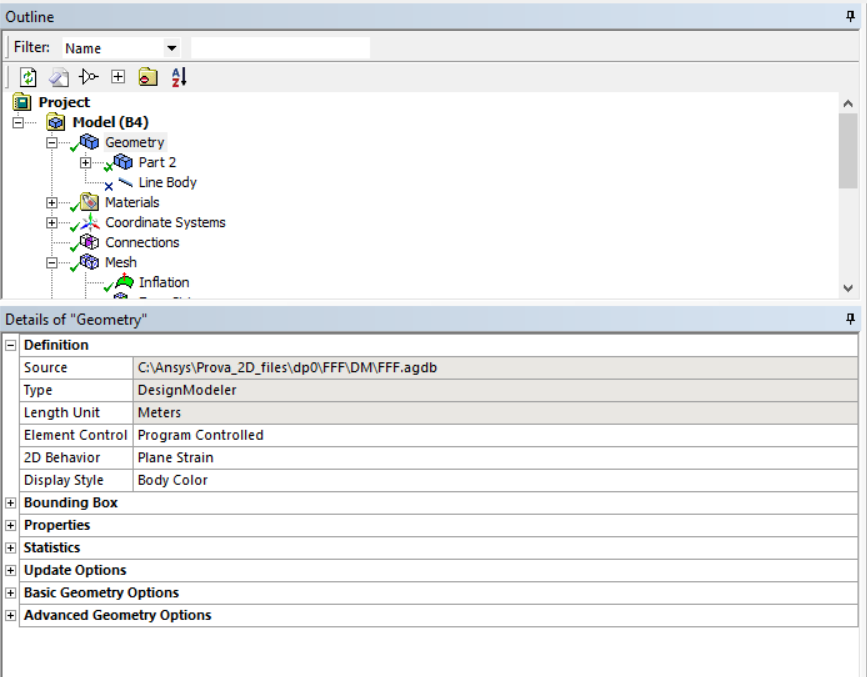TAGGED: 2-d, transient-structural
-
-
October 16, 2020 at 4:17 pm
francescone96
SubscriberHi everybody,
I started another discussion yesterday on the same analysis, but this time the problem is
slightly different: i have a 2D geometry and i want a plane strain state. I click on the "plane strain" window as in the following figure
October 19, 2020 at 12:55 pmJJ_Thompson
SubscriberI doubt that the use of the enhanced strain formulation is the cause of your problem. Those internal degrees of freedom help to also capture bending stress that linear elements are known to be bad at.nNow back to your question, you can change the element technology by setting the following: n!TURN OFF AUTOMATIC SELECTION OF ELEMENT TECH nETCONTROL,OFF, ON n!SET THE ELEMENT TO PLANE 182 WITH WITH FULL INTEGRATION nET,MATID,PLANE182nKEYOPT,MATID,1,0n!SET THE BEHAVIOUR TO PLAIN STRAIN nKEYOPT,MATID,3,2nnmaybe if you share more details about your problem and show geometry and BC, i ca better understand your problem. nOctober 20, 2020 at 7:53 amfrancescone96
SubscriberThank you a lot for the APDL command and for the fast reply. nHowever i still get strain along Z. Do i have to insert the APDL command on the geometry of the body? n The problem is a 2D disk (i'm really sorry i'm not allowed to share pics of the problem despite is very simple) and in transient structural i'm evaluating the circumferential stress of the disk with the time. nThe load comes from a thermal transient analysis in fluent, i export the thermal field for each time-step. The stress comes from the temperature gradient along the radius of the disk. nAs i said i need to get plain strain from this analysis, so the strain along z (normal direction of the plane) has to be zero. I also tried to make the mesh in APDL and then exporting it to workbench, but it did not work. No constraints are applied. nOctober 20, 2020 at 10:03 amfrancescone96
SubscriberI solved the problem by modifying the material model: i changed the coefficient of thermal expansion from isotropic to orthotropic by putting the coefficient of thermal expansion along z equal to zero. In this way i do not get any thermal expansion along the normal direction and so thermal strain. As i read in literature the stress sigma has to be non-zero and is what i get. nCould this be correct?nOctober 20, 2020 at 6:49 pmJJ_Thompson
SubscriberHello, nGlad to know you have solved your problem. I think what you have done is correct. In the apdl theory reference (page 6, v19.2) , you will find that ansys allows for different coefficient of thermal expansion in the element basis direction so i suspect that by using the orthotropic option and setting that coefficient to zero in z direction, no thermal strains are generated in that direction. That makes sense to me.You are correct, the stresses in the plain strain are nonzero in z direction. at least for linear elasticity you can check this from elementary calculations.Viewing 4 reply threads- The topic ‘Enhanced strain formulation for plane strain 2D analysis’ is closed to new replies.
Ansys Innovation SpaceTrending discussionsTop Contributors-
3597
-
1273
-
1107
-
1068
-
953
Top Rated Tags© 2025 Copyright ANSYS, Inc. All rights reserved.
Ansys does not support the usage of unauthorized Ansys software. Please visit www.ansys.com to obtain an official distribution.
-
The Ansys Learning Forum is a public forum. You are prohibited from providing (i) information that is confidential to You, your employer, or any third party, (ii) Personal Data or individually identifiable health information, (iii) any information that is U.S. Government Classified, Controlled Unclassified Information, International Traffic in Arms Regulators (ITAR) or Export Administration Regulators (EAR) controlled or otherwise have been determined by the United States Government or by a foreign government to require protection against unauthorized disclosure for reasons of national security, or (iv) topics or information restricted by the People's Republic of China data protection and privacy laws.












